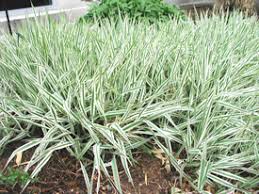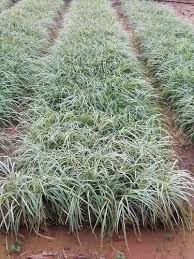Ribbon Grass, scientifically known as Phalaris arundinacea, is a type of grass that is often admired for its elegant appearance and versatility. With its scientific name derived from “Phalaris” which means “shining” and “arundinacea” meaning “reed-like,” this grass lives up to its name by adding a touch of brightness wherever it grows.
This grass plant is quite popular in gardens and landscaping due to its striking features. Ribbon Grass typically has long, slender leaves that resemble ribbons, giving it a distinct and graceful look. These leaves can be variegated, meaning they have stripes or patterns of different colors. Commonly found in shades of green and white, these variegated leaves create a beautiful contrast that captures the eyes of those who behold them.
One of the reasons why Ribbon Grass is favored by many garden enthusiasts is its adaptability. This grass can thrive in a variety of conditions, from sunny areas to partially shaded spots. It can also tolerate different types of soil, making it a versatile choice for different landscapes. Whether you have a formal garden or a more relaxed outdoor space, Ribbon Grass can find its place and flourish.
In addition to its aesthetic appeal, Ribbon Grass also serves practical purposes. It can be planted to create natural borders or edgings in gardens. Its dense growth can help prevent soil erosion on slopes and banks. Moreover, some people use Ribbon Grass to add privacy to their yards, as the tall growth can act as a screen when strategically planted.
Caring for Ribbon Grass is relatively simple. Regular watering, especially during dry spells, will help maintain its lush appearance. Trimming back the grass in late winter or early spring can promote healthy growth for the coming season. However, it’s important to keep an eye on its spread, as Ribbon Grass can sometimes be quite enthusiastic in its growth and might need some containment.
In addition, Ribbon Grass (Phalaris arundinacea) is a charming and versatile plant that adds an elegant touch to gardens and landscapes. With its ribbon-like leaves and adaptability to various conditions, it’s a popular choice for both experienced and novice gardeners. Whether used for its beauty, practicality, or both, Ribbon Grass stands as a shining example of nature’s simple yet captivating wonders.
Read Also: Strawberry Petioles: Economic Importance, Uses and By-Products
Growing and Care Guide of Ribbon Grass

Growing and caring for Ribbon Grass (Phalaris arundinacea) can be a rewarding experience, as this versatile plant adds charm to gardens and landscapes. Here’s a simple guide to help you successfully cultivate and maintain Ribbon Grass:
1. Choosing the Right Location: Select a location that receives either full sun or partial shade. Ribbon Grass can adapt to different light conditions, making it suitable for a variety of spots in your garden.
2. Soil Preparation: Prepare well-draining soil that’s rich in organic matter. While Ribbon Grass can tolerate different soil types, providing good drainage will help prevent waterlogged roots.
3. Planting: Plant Ribbon Grass in spring or fall. Dig a hole slightly larger than the plant’s root ball and place the grass in the hole. Fill with soil and gently pat it down. Water thoroughly after planting.
4. Watering: Keep the soil consistently moist, especially during the plant’s establishment period. Once it’s established, Ribbon Grass can tolerate some drought, but regular watering will ensure healthy growth.
5. Fertilizing: Apply a balanced, slow-release fertilizer in spring to provide the necessary nutrients for optimal growth. Follow the manufacturer’s instructions for application.
6. Pruning: In late winter or early spring, trim back the old growth to encourage new shoots to emerge. This also helps prevent the plant from becoming too invasive.
7. Controlling Spread: Ribbon Grass can spread vigorously through rhizomes. To prevent it from taking over your garden, consider planting it in containers or using physical barriers to restrict its growth.
8. Variegated Varieties: If you’re growing a variegated variety of Ribbon Grass, ensure it receives enough light to maintain the color contrast in its leaves. Inadequate light may cause the leaves to become mostly green.
9. Division: Every few years, consider dividing the plant to control its size and rejuvenate its growth. Divide in spring or fall by digging up the clump, separating the rhizomes, and replanting the divisions.
10. Pest and Disease Management: Ribbon Grass is generally resistant to pests and diseases. However, keeping the area clean and providing proper spacing between plants can help prevent any potential issues.
11. Winter Care: Ribbon Grass is hardy in most climates and can survive cold winters. Apply a layer of mulch around the base of the plant in late fall to protect the roots from freezing temperatures.
By following these simple guidelines, you can successfully grow and care for Ribbon Grass. Its elegant appearance and adaptability make it a valuable addition to any garden or landscape. Just remember to keep an eye on its growth and spread to ensure it remains a beautiful and well-behaved part of your outdoor space.
Benefits of Ribbon Grass

Ribbon Grass (Phalaris arundinacea) offers several benefits that make it a valuable addition to gardens and landscapes:
1. Erosion Control: Ribbon Grass has a dense growth habit, making it an effective plant for preventing soil erosion on slopes, banks, and other vulnerable areas. Its roots help stabilize the soil, reducing the risk of runoff and soil loss.
2. Aesthetic Appeal: The ribbon-like leaves of this grass create a visually striking appearance. The variegated varieties, with their contrasting colors, add a touch of elegance and beauty to gardens, borders, and outdoor spaces.
3. Versatility: Ribbon Grass can adapt to different light conditions, from full sun to partial shade. It’s also relatively adaptable to various soil types, allowing it to thrive in diverse environments.
4. Low Maintenance: Once established, Ribbon Grass requires minimal care. It’s a hardy plant that can tolerate some drought and doesn’t need frequent fertilization. Its growth habit reduces the need for regular pruning, making it a low-maintenance choice for landscaping.
5. Privacy and Screening: The tall growth of Ribbon Grass can be used strategically to create natural screens or privacy barriers in gardens. It can be planted in rows to offer a visually appealing way to separate different areas of your outdoor space.
6. Wildlife Habitat: Ribbon Grass provides habitat and shelter for small wildlife, such as birds, insects, and other beneficial creatures. This can contribute to a healthier ecosystem in your garden.
7. Air Quality Improvement: Like other plants, Ribbon Grass contributes to improving air quality by absorbing carbon dioxide and releasing oxygen. It can play a small but positive role in creating a healthier environment around your home.
8. Soil Improvement: As a grass plant, Ribbon Grass contributes to soil health by preventing erosion and adding organic matter as it sheds leaves and other plant material.
9. Easy Propagation: Ribbon Grass can be propagated easily through division. This means you can create more plants from an existing one without much effort, making it a cost-effective way to expand your garden.
10. Educational Value: Growing Ribbon Grass can serve as an educational opportunity for children and adults alike. Observing its growth patterns, learning about its adaptability, and exploring its role in the ecosystem can be a fun and informative experience.
However, Ribbon Grass offers a range of benefits, from its practical uses in erosion control and privacy screening to its aesthetic appeal and minimal maintenance requirements. Its adaptability and versatility make it a valuable asset for various landscaping projects and gardening endeavors.
Read Also: 10 Medicinal Health Benefits of Milicia excelsa (African Teak)
Where to Find Ribbon Grass near Me/You
Here are three perfect places where Ribbon Grass (Phalaris arundinacea) can be located or planted:
1. Garden Borders: Ribbon Grass can be used effectively as a border plant to define the edges of garden beds. Its upright growth and elegant appearance create a neat and visually appealing separation between different sections of your garden. The variegated varieties can add a touch of color and contrast, enhancing the overall aesthetics of your landscape.
2. Slopes and Embankments: Due to its ability to prevent soil erosion, Ribbon Grass is an excellent choice for planting on slopes or embankments. The dense growth of its roots helps stabilize the soil, reducing the risk of erosion caused by water runoff. This not only serves a functional purpose but also adds a natural and attractive element to otherwise challenging areas.
3. Privacy Screens: If you’re looking to create privacy in your outdoor space, consider planting Ribbon Grass in rows to form a living screen. The tall and dense growth of the grass can provide a barrier that visually separates your yard from neighboring properties or busy streets. This approach offers a more aesthetically pleasing alternative to traditional privacy fences.
Remember to consider the specific light conditions and soil types of these locations when planting Ribbon Grass. Whether you’re aiming for functional benefits like erosion control or aesthetic enhancements, Ribbon Grass can thrive and contribute to the beauty of these well-chosen locations.
Read Also: 5 Ways to Properly Dispose your Metal Wastes
